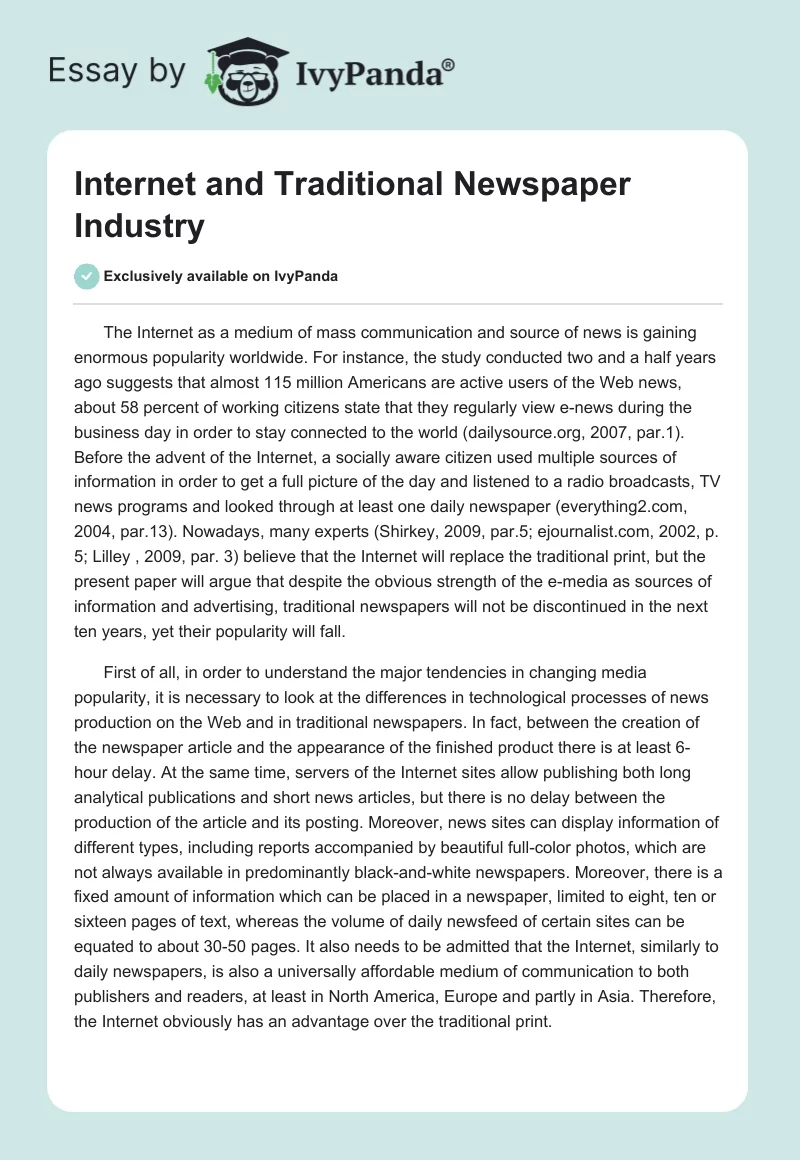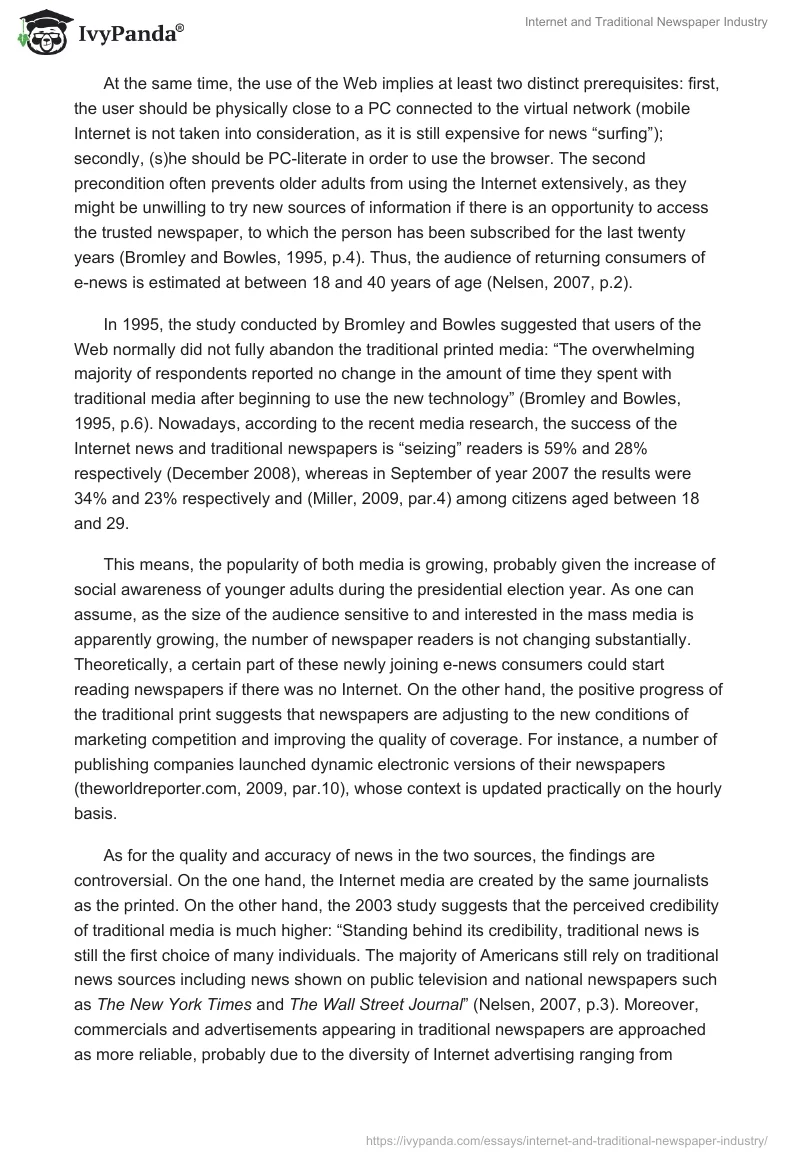The Internet as a medium of mass communication and source of news is gaining enormous popularity worldwide. For instance, the study conducted two and a half years ago suggests that almost 115 million Americans are active users of the Web news, about 58 percent of working citizens state that they regularly view e-news during the business day in order to stay connected to the world (dailysource.org, 2007, par.1). Before the advent of the Internet, a socially aware citizen used multiple sources of information in order to get a full picture of the day and listened to a radio broadcasts, TV news programs and looked through at least one daily newspaper (everything2.com, 2004, par.13). Nowadays, many experts (Shirkey, 2009, par.5; ejournalist.com, 2002, p. 5; Lilley , 2009, par. 3) believe that the Internet will replace the traditional print, but the present paper will argue that despite the obvious strength of the e-media as sources of information and advertising, traditional newspapers will not be discontinued in the next ten years, yet their popularity will fall.
First of all, in order to understand the major tendencies in changing media popularity, it is necessary to look at the differences in technological processes of news production on the Web and in traditional newspapers. In fact, between the creation of the newspaper article and the appearance of the finished product there is at least 6-hour delay. At the same time, servers of the Internet sites allow publishing both long analytical publications and short news articles, but there is no delay between the production of the article and its posting.
Moreover, news sites can display information of different types, including reports accompanied by beautiful full-color photos, which are not always available in predominantly black-and-white newspapers. Moreover, there is a fixed amount of information which can be placed in a newspaper, limited to eight, ten or sixteen pages of text, whereas the volume of daily newsfeed of certain sites can be equated to about 30-50 pages. It also needs to be admitted that the Internet, similarly to daily newspapers, is also a universally affordable medium of communication to both publishers and readers, at least in North America, Europe and partly in Asia. Therefore, the Internet obviously has an advantage over the traditional print.
At the same time, the use of the Web implies at least two distinct prerequisites: first, the user should be physically close to a PC connected to the virtual network (mobile Internet is not taken into consideration, as it is still expensive for news “surfing”); secondly, (s)he should be PC-literate in order to use the browser. The second precondition often prevents older adults from using the Internet extensively, as they might be unwilling to try new sources of information if there is an opportunity to access the trusted newspaper, to which the person has been subscribed for the last twenty years (Bromley and Bowles, 1995, p.4). Thus, the audience of returning consumers of e-news is estimated at between 18 and 40 years of age (Nelsen, 2007, p.2).
In 1995, the study conducted by Bromley and Bowles suggested that users of the Web normally did not fully abandon the traditional printed media: “The overwhelming majority of respondents reported no change in the amount of time they spent with traditional media after beginning to use the new technology” (Bromley and Bowles, 1995, p.6). Nowadays, according to the recent media research, the success of the Internet news and traditional newspapers is “seizing” readers is 59% and 28% respectively (December 2008), whereas in September of year 2007 the results were 34% and 23% respectively and (Miller, 2009, par.4) among citizens aged between 18 and 29.
This means, the popularity of both media is growing, probably given the increase of social awareness of younger adults during the presidential election year. As one can assume, as the size of the audience sensitive to and interested in the mass media is apparently growing, the number of newspaper readers is not changing substantially. Theoretically, a certain part of these newly joining e-news consumers could start reading newspapers if there was no Internet. On the other hand, the positive progress of the traditional print suggests that newspapers are adjusting to the new conditions of marketing competition and improving the quality of coverage. For instance, a number of publishing companies launched dynamic electronic versions of their newspapers (theworldreporter.com, 2009, par.10), whose context is updated practically on the hourly basis.
As for the quality and accuracy of news in the two sources, the findings are controversial. On the one hand, the Internet media are created by the same journalists as the printed. On the other hand, the 2003 study suggests that the perceived credibility of traditional media is much higher: “Standing behind its credibility, traditional news is still the first choice of many individuals. The majority of Americans still rely on traditional news sources including news shown on public television and national newspapers such as The New York Times and The Wall Street Journal” (Nelsen, 2007, p.3). Moreover, commercials and advertisements appearing in traditional newspapers are approached as more reliable, probably due to the diversity of Internet advertising ranging from amateur messages causing doubts and rejection to well-crafted designer pictures which at least attract attention and incite interest. It also needs to be admitted that the newspapers with 100-year history and reputation have strict filtering policies concerning commercial articles (Brook, 2007, par.7) and are not likely to accept overtly irritating messages.
As one can conclude, due to the fact that traditional newspaper are still referred to as time-honored brands, they are not likely to easily yield to the Internet media. However, the overall impact of the Internet on newspaper industry is tremendous, and the younger readers are nowadays more likely to monitor web-sites instead for news instead of looking through newspapers, so the audiences of newspapers are gradually ageing.
Reference list
Daily Source. (2007). The Growing Impact of the Internet. Web.
Shirkey, C. (2009). Society doesn’t need newspapers, it needs journalism. Web.
Bromley, R. and Bowles, D. (1995). Impact of Internet on use of traditional news media. Newspaper Research Journal. Web.
Nelsen, M. (2007). Traditional and Nontraditional News Sources: The Impact of the Internet. Web.
Everything to Know. What has been the impact of the Internet on global news services? Web.
Miller, D. (2009). Internet Surpasses Newspapers. Web.
Brook, S. (2007). Impact of internet ‘overstated’, says Bailey. Web.
Ejournalist. (2002). Understanding the Impact of the Internet. Web.
Liley, B. (2009). Craigslist killed the newspaper. Web.
The World Reporter. (2009). The Internet and the Newspaper Crisis … who didn’t see this coming? Web.


